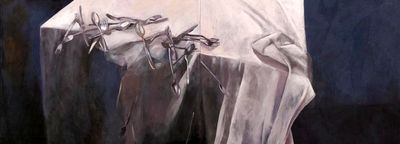Teer Art, Iran’s first ever art fair, will be held at Ava Center, a shopping mall in north Tehran, on June 26, 28, 29 and 30, Honaronline reported on its Persian website.
Organized by Hormoz Hemmatian, director of Dastan Gallery and managed by Maryam Majd from Assar Art Gallery, the fair will see the participation of 10 Tehran galleries specializing mainly in contemporary art including Dastan, Ab-Anbar, O, Assar, Etemad, Ag, Khak, Shirin, Azad and Mohsen.
At Teer, one can expect to browse a selection of local art culled from the 10 well-known galleries. The event offers 80 new creations and previously unseen works by 70 artists, according to Harpersbazaararabia.com.
“It is rare that art collectors pay a visit to a gallery. They go to fairs and fill up their carts,” said Salman Matinfar, director of Ab-Anbar Art Gallery. “If we want to get out of our comfort zones and become more international, such fairs as Teer are the only way.” Ab-Anbar Gallery also intends to present an extension of its current exhibition by New York-based Iranian painter Y. Z. Kami at the fair.
“Teer allows the audience to view the most interesting and exciting artworks from Tehran galleries,” Hemmatian said. “We see the fair as an opportunity for galleries and the audience to build a closer rapport around contemporary art.”
Teer aims at offering insight into the rich, culturally significant works of galleries ranging from sculptural works to paintings and photographs.
Founding director of O Gallery, Orkideh Daroodi sees the fair as a welcome addition that will attract a more diversified crowd in addition to existing collectors. “The fact that this is the first time this number of galleries come together, surely creates countless opportunities to promote our artists on a bigger scale,” said Daroodi.
At the fair, O Gallery will maintain its focus on figurative art and works on paper. There will be two works on paper by Omid Moshksar, two oil paintings by Omid Bazmandegan, a large-scale painting by Mohammad Khalili, and Shadi Tami’s deeply contemplative self-portraits.
“I think the fair will help motivate and inspire gallerists and artists to think outside the box. Our art system needs to believe in itself and Teer might just do that,” Daroodi added.
“We are trying to represent a more realistic image of Iranian art. For many galleries, it is impossible to take part in international art fairs due to the currency crisis as well as travelling challenges,” Hemmatian pointed out.
Cultural Exchange
“I believe both Iran and the international community will benefit from cultural exchange. Teer would be an excellent platform to achieve this,” founder and director of Shirin Art Gallery, Shirin Partovi said.
“Teer Art can be compared to a miniature museum where galleries can represent and study the works of artists in a way that might not be easily accomplished in the format of gallery shows,” Partovi noted, adding that her gallery will showcase a gripping mix of works by Vahid Chamani, Farnaz Rabieejah, Mohammad Tabatabai and Sepehr Bakhtiar.
Part of the fair’s highlights is a section titled ‘Beyond’, which will feature large-scale sculptural works. Following in the footsteps of many prominent international art fairs, Teer will include talks and panel discussions on collecting works, art events and the global art market.
According to the London-based market research firm ArtTactic’s latest report, Iranian artists far outperform their Middle Eastern peers at global auctions. In 2017, Iranian artists generated £16.6m ($22m) in sales, way ahead of second-placed Egypt, whose artists made £5.4m ($7.2m).
“Without cultural and economic exchanges between Iran and the West, the Iranian art scene will become ghettoized once again,” Matinfar said.
Iranians have lived with economic sanctions since 2006 when the country refused to suspend its uranium enrichment program. But many say the situation has become far worse in recent months.
“Not only have Iranian gallerists not been able to travel to the US for studio visits, we haven’t been able to even negotiate insurance and shipment issues” Matinfar said. Furthermore, lengthy and cumbersome visa processes have “discouraged many artists, curators and museum directors to curtail, if not cancel, their trips to Iran”.
Alexander Heller, son of the Iranian expatriate Leila Heller who owns the eponymous New York and Dubai-based gallery, said Iran’s domestic market is “very active but Iran-specific”. Since the Iranian national currency (rial) plummeted, the gallery has “halted doing business in Iran because collectors there are mainly trading among each other.”
Heller said the renewed sanctions will weaken the economy further and “create levels of monopoly in the market, where wealth is concentrated in a few hands”.
Riley Frost, co-founder of CAMA gallery with branches in Tehran and London, points out that “modern” masters with international profiles such as Parviz Tanavoli are less likely to be affected by the recent upheavals than those artists building a career. Ava Center is located on Movahed Danesh Street, southeast of Niavaran Park at the northern tip of Pasdaran Street.
Source: Financial Tribune

